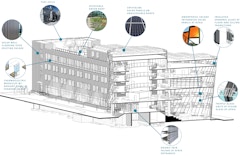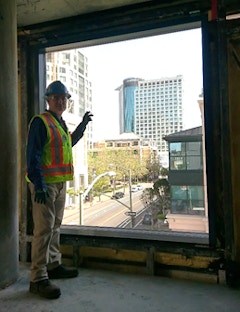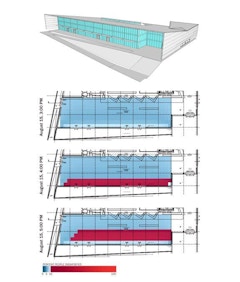
295 results
-
 As building enclosure consulting services evolve and mature in markets, the scopes of service that are provided and sought, can become more…
As building enclosure consulting services evolve and mature in markets, the scopes of service that are provided and sought, can become more… -

Innovations with Glass
- Paper by Jens Schneider, S. Müller-Braun, T. Peters, M. Schuster,
Glass has become a popular building material that is used not only for windows but also as a load-bearing material. New dimensions of glass panes in… -

Adaptable Glazing Shields
- Paper by Anas Al Kassas
Today, about 40% of all buildings in the U.S. still have single-pane windows, and ~70% of the existing building stock is estimated to suffer from
-

Sustainable Retrofit Strategies for an Existing Laboratory Building
- Paper by Suncica Milosevic · Ajla Aksamija
This paper analyzes sustainable retrofit strategies for an existing research laboratory building, located in a cold climate. This facility is
-
Wind-Borne Debris Impacts on Façades
- Paper by Angela Mejorin, Ph.D., Researcher
Climate change effects are causing an increase in extreme wind events’ frequency and severity, worldwide. Regions that previously were not prone to
-

Facade Mock-ups
- Paper by Andy Lang, AScT
Curtain walls and window walls are typically specified to meet a variety of different performance and testing criteria, some of which can be quite
-
Direct Sun and Occupant Comfort
- Paper by Madeline Gradillas · Henry Richardson
Direct sun on the body is a known potential cause of thermal discomfort for occupants, yet most thermal comfort simulations do not capture its
-
Sustainable Façades
- Paper by Dr. Thomas Henriksen · Jean-Marc Moulin Norsk · Dr. Jacopo Montali
Transposing innovation from government funded research to commercially viable solutions becomes ever more important when combined with the urgent
-

European Facade Networks
- Paper by Ulrich Knaack · Uta Pottgiesser · Tillmann Klein · Andreas Luible · Siebe Bakker
The European climate and energy targets for 2020 demand significant improvement of the energy performance of buildings since one third of the
-
Interstitial condensation risk assessment
- Paper by Jelle Langmans · Piet Houthuys · Wout Parys · Staf Roels
The development of methods to predict and control moisture accumulation in building envelopes has always been a key element in building science.
-

Infinite Panel System
- Paper by Mike Ryan · Brian Stern · Michael Adams
Today, building facades are expected to do much more than merely provide shelter, which is driving the need for higher performing envelope solutions.
-
Creating Transformational Geometry
- Paper by Tom Peterson · Austin Bensend, PE, SE
Over the past two decades, the art of cold-forming glass has grown from an unknown approach to a widely accepted strategy for achieving an array of
-

Modern Heritage and Facade Improvements
- Paper by Uta Pottgiesser, Angel Ayón,
Approximately 80% of our total building stock is from the 20th century. During the last decades, along with an increasing appreciation of modern… -

Ceramic Precast Composite Panels
- Paper by Edward Rubio, Edward J. Rubio, Gregory Lucier, Ph.D., Brian Moskow, PE, Sami H. Rizkalla, Ph.D., FACI, FASCE, FEIC, FCSCE, FIIFC, FPCI,
An innovative lightweight ceramic precast composite panel is introduced in this paper that offers the unique benefits of prefabricated off-site… -
Contextualizing Glass and Carbon Impacts
- Paper by Kayla Natividad, PhD, WELL AP, LEED Green Associate · Kyle Sword
Climate change goals will require significant improvements in the way buildings are constructed and operated. Building reuse can combat climate
-

Addressing Embodied Carbon
- Paper by Helen Sanders, PhD · Adam Nizich
Reducing greenhouse gas emissions from the building sector is critical to limiting global temperature rise to less than 1.5⁰C. Construction and
-

The Versatile Envelope Garden
- Paper by Nathaniel Barlam · Yunyao Lin · Ben Silverman
Facades play an integral role in defining the experience of modern life. As rising populations gravitate from rural to urban communities, they bring
-

The Myth of Simplicity
- Paper by Gerry Lang,
There were good why reasons early US Modernism first evolved in California– wide open sites with no constraints (physical or zoning), and effectively… -

Reinforced Polymer Concrete Screen Walls
- Paper by Brock DeSmit, Partner Jessica Hong, Lead Designer Becher Eli Neme, Principal, Founder
Apertures is a six-story, commercial building in the Roma Norte neighborhood of Mexico City–a neighborhood severely impacted by the 1985 and 2017… -

Passively Actuated Systems
- Paper by Manuel Benitez Ruiz · David Gerber
Kinetic or responsive facades have been developed to improve buildings' daylighting conditions while mitigating energy consumption. Still, these
